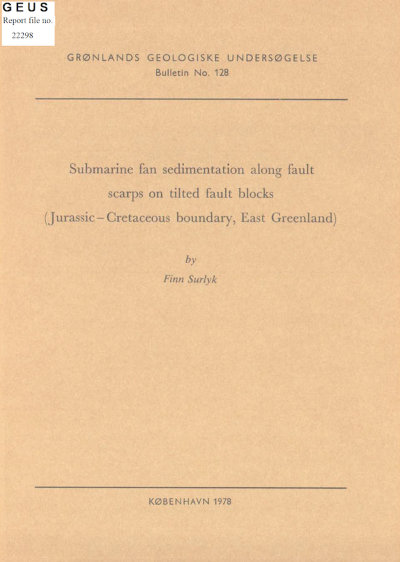Submarine fan sedimentation along fault scarps on tilted fault blocks (Jurassic-Cretaceous boundary, East Greenland)
DOI:
https://doi.org/10.34194/bullggu.v128.6670Abstract
In late Jurassic times large-scale faulting, which partly occurred along old lines of weakness, fragmented the East Greenland shelf into several westerly tilted blocks. The sediments of the syntectonic Middle Volgian-Valanginian Wollaston Forland Group were deposited along and away from the fault scarps formed at the uptilted western margin of each block. To the west the group comprises thick syntectonic clastic wedges of submarine rock-fall breccias which pass laterally into thick conglomerates and sandstones deposited by various types of sediment gravity flow. Further to the east these facies pass rapidly into mudstones. The depositional regime was characterized by repeated fault activity resulting in deepening of the depositional basins, followed by rapid erosion of borderlands and sedimentation of very coarse clastic sediments on a narrow coastal fringe of fan-deltas leading into submarine fans. This pattern continued into Ryazanian time (early Lower Cretaceous), and in the Valanginian a major regional transgression initiated an open shelf where light grey mudstones and sandstone turbidites were deposited. These Middle Volgian to Valanginian sediments are interpreted as showing a progressively collapsing and submerging platform. The model presented for submarine sedimentation along fault scarps on tilted fault blocks displays the same facies associations as the one for deep-sea fans. Distinguishing characters are seen in the intern al distribution of facies. The sediment prism is arranged in several hundred metres thick fining-upward megacycles corresponding to major phases of faulting and down-tilting of fault blocks. They also indicate gradually diminishing sediment supply following rapid erosion and retreat of borderlands. Megacycles are internally composed of fining-upward cycles a few metres to tens of metres thick. These cycles reflect progressive tilling and abandonment of inner and midfan channels. The very coarse-grained proximal units wedge out very rapidly in a distal direction where the seaward dipping fan slope is checked due to the dip slope of the opposite fault block.
Downloads
Published
Issue
Section
License
This article is distributed under a CC-BY 4.0 licence, permitting free redistribution and reproduction for any purpose, even commercial, provided proper citation of the original work. Author(s) retain copyright over the article contents.


